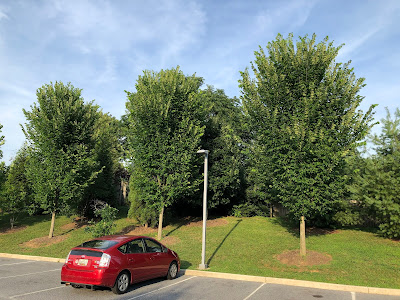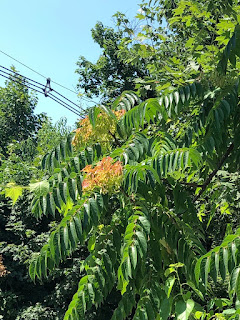This covers the area from the group at the southeast corner already listed, all the way to the northeast corner of the main parking lot where there is a grassy plot. There is no obvious order, hard to map specific trees but there are only a few varieties, elms, maples, oaks, locust, tulip poplar, sycamore , white pine, cryptomeria , arbor vitae, scattered bushes of serviceberry and more fringe tree. So we will try to show one of each and let you extend it to the other similar trees.
The last tree in the previous group was the small elm next to the parking lot, there is a grassy gap and then this next group. Standing on the first light pole on the east side, there is a maple to your right, and two maples near the pavement to your left. Up the hill is a group of five white pines. Their needles come in groups of five which equals the letters in "white". You may be able to see the life cycle close up, male and female flowers, before the trees get too tall. Or these are relatively close, may be a cultivar that will remain small. Not the original Eastern White Pine desired for British ship's masts, that started the revolutionary war.
 |
One of the thee maples on east edge of parking lot
|
 |
Part of a group 5 white pines East of the lot.
|
Standing at the second, going north, light pole and facing east, you have an elm to your right, and two elms to the left. Step back a little and note the shape and height of the three elms. Straight up the hill is a small maple, behind that a fir tree and at the fence a small oak. There is an invasive little tree of Heaven growing in the fir tree. A little left at the fence is an older tree, probably also a tree of Heaven.
 |
Leaf of elm with asymmetrical base.
|
 |
Fir tree with small Tree of Heaven
|
 |
Flat needles on the fir
|
 |
Red oak at the back fence east side.
|
 |
View of the east side with the three vase like upward reaching elms.
|
From the last light pole on the tongue of grass projecting into the parking lot, the first tree is a honey locust , slightly further east and left is a tulip poplar, then three fringe trees around the last or most northern elm. Straight up the hill there is a group of arbor vitae, with a small oak behind near the fence. In the back, between the arbor vitae to the north and the white pines to the south is a small group of conifers. I think there are both firs and spruce here but will confirm.
 |
Leaves of the tulip poplar
|
 |
locust tree on grassy projection
|
 |
Arbor vitae
|
 |
Spruce near the top of hill east plantings
|
 |
Serviceberry
|
 |
One of a group of three Fringe Trees
|
North from the tongue of grass, There is another arbor vitae midway up the hill, two tulip populars and a group of 4-5 serviceberries. At the back near the fence are three mixed oaks, red and white. At the next light pole looking east, there is a sickly oak to the left, and two large cryptomeria near the back fence. Middle of this section there are two more oaks in front and arbor vitae near the fence in the back. Behind these at the fence is an old box elder.
 |
Sickly oak east parking lot, unknown type
|
 |
Leaves of the box elder look a little like poison ivy
but this is the trunk |
 |
Two large crytomeria
|
Standing at the last grassy projection into the parking lot, looking east, there is another locust tree, a tulip tree, a group of small sycamores, and a couple of hollies. To the left and down the hill are a couple of Virginia pines. East and a little south of the last light pole is a little different tree, suspect an American Hornbeam. At the very back, east, is another box elder. Judging by the growth at the bottom the dead tree may have been a Tree of Heaven. Since it is invasive, not sure it had a natural death.
Even with duplicates that is a lot of trees, the pictures show just some representative images, not all of the individual trees.
 |
two views of the needles, bunches of two, on the
Virginia pine
|
 |
The leaf and the trunk of the Sycamore
Large leaves preferred by Adam and Eve
|
 |
Sick-a-more trunk.
Not as disease, an art form |
 |
Leaves of the hornbeam, not a familiar tree
|
 |
Possible "muscular " trunk of the hornbeam.
|
 |
End of July seeds of the hornbeam
|





























Comments
Post a Comment